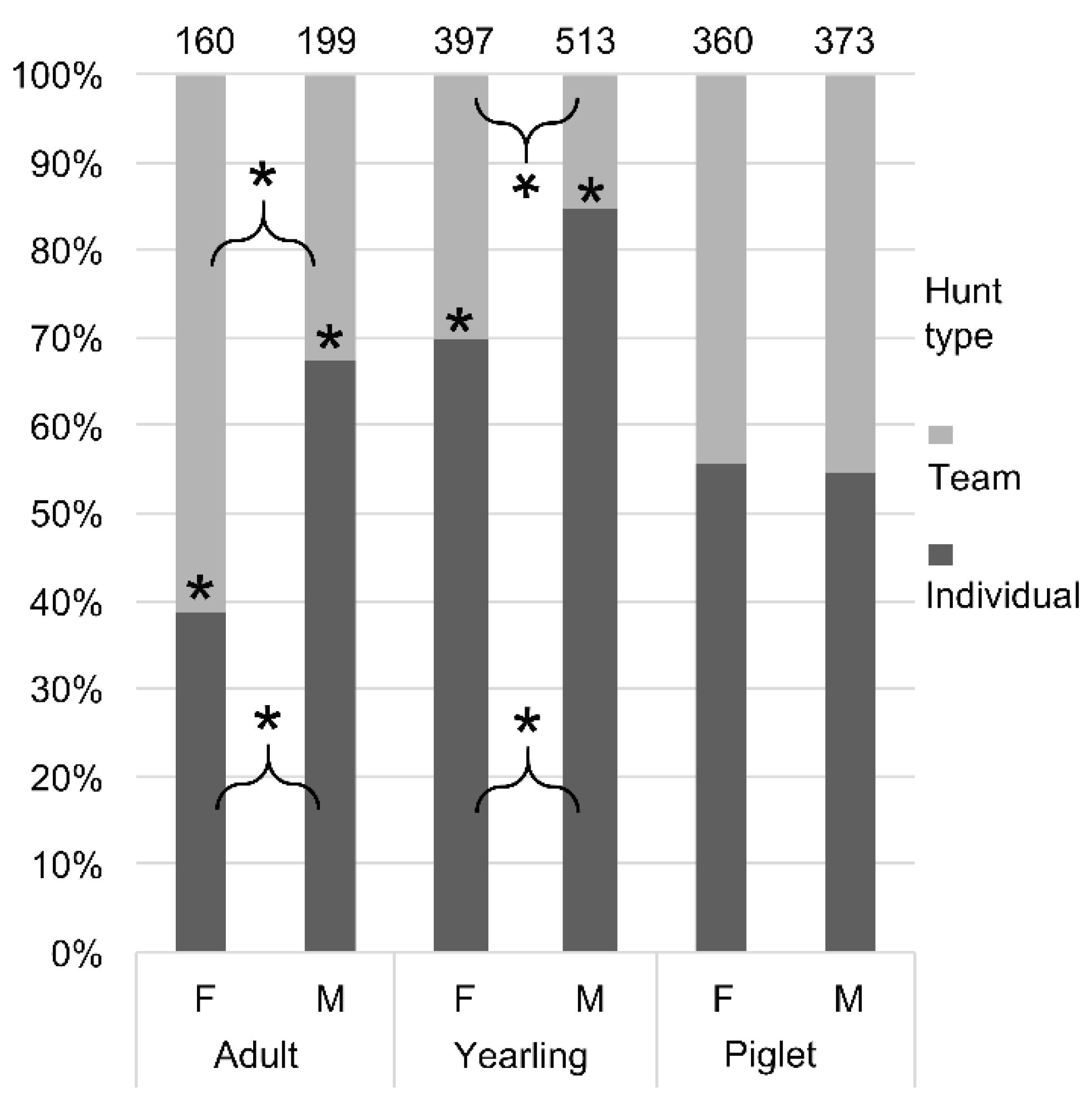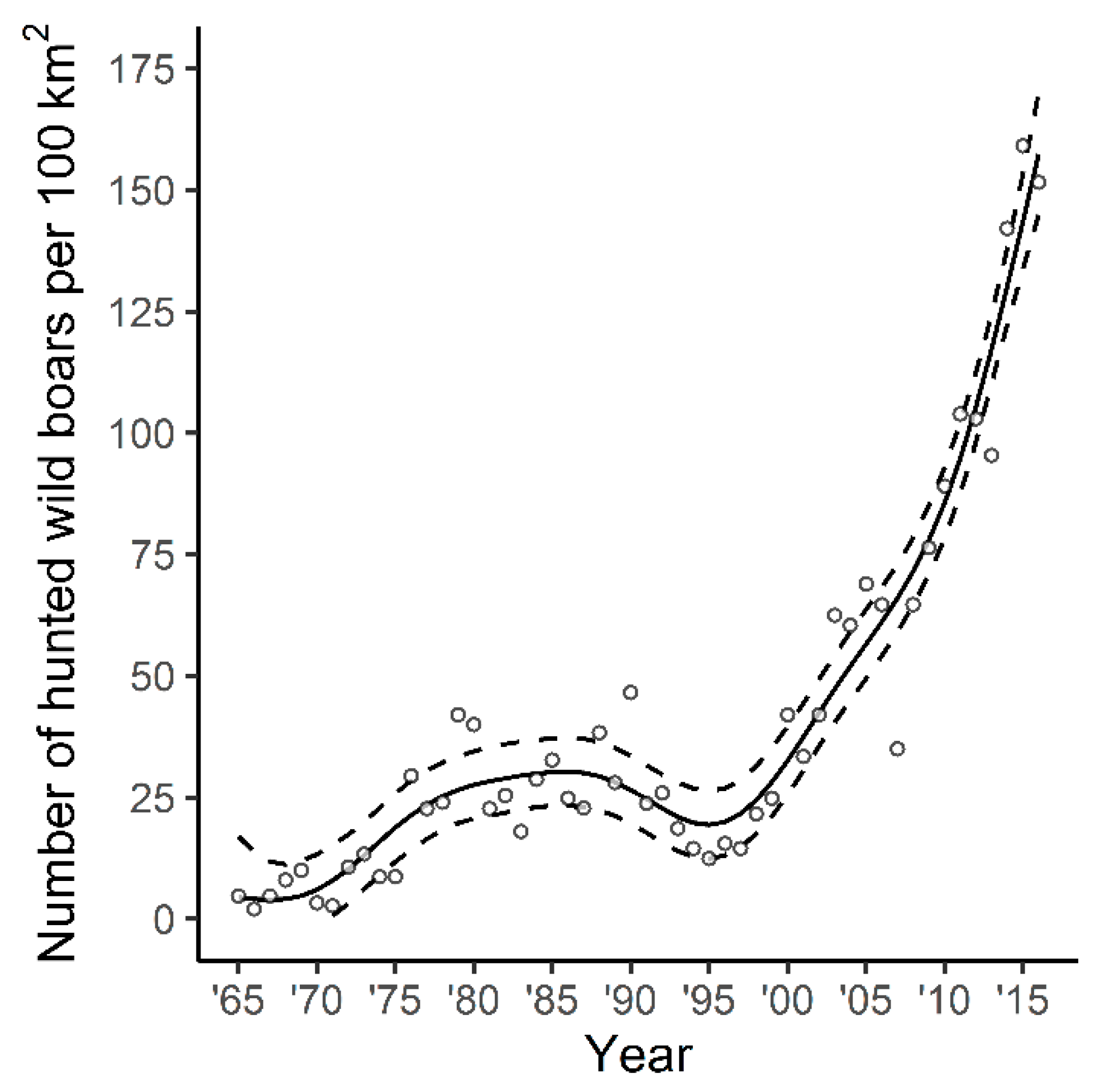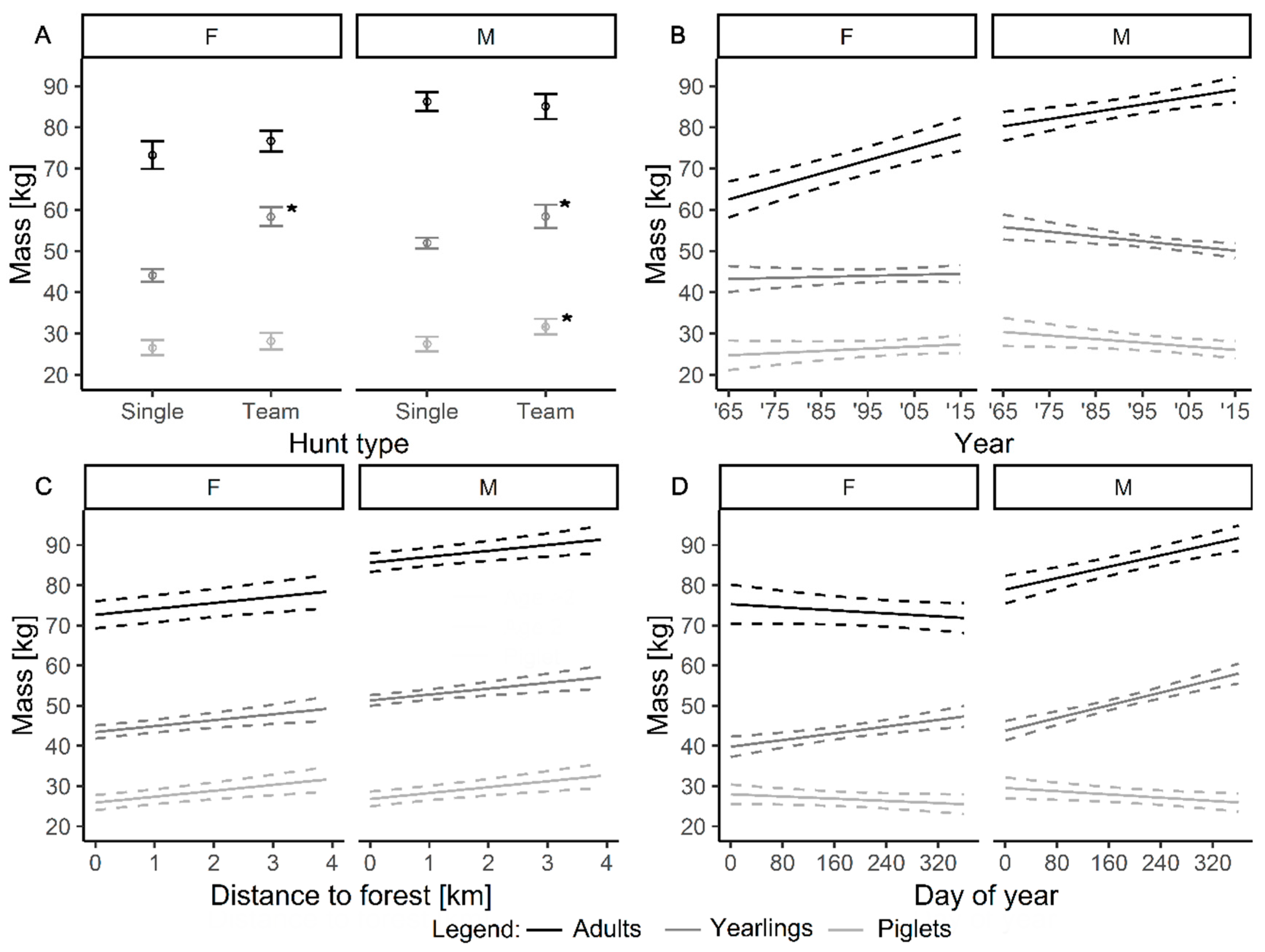The Relationship between Hunting Methods and the Sex, Age and Body Mass of Wild Boar Sus scrofa
Abstract
Simple Summary
Abstract
1. Introduction
2. Materials and Methods
2.1. Study Area
2.2. Hunting Data
2.3. Frequency of Hunting and Culling
2.4. Annual Numbers
2.5. Body Mass of Culled Wild Boar
3. Results
3.1. Frequency of Culling
3.2. Annual Numbers
3.3. Body Mass of Culled Wild Boar
4. Discussion
5. Conclusions
Supplementary Materials
Author Contributions
Funding
Acknowledgments
Conflicts of Interest
References
- Barrios-Garcia, M.N.; Ballari, S.A. Impact of wild boar (Sus scrofa) in its introduced and native range: A review. Biol. Invasions 2012, 14, 2283–2300. [Google Scholar] [CrossRef]
- Andrzejewski, R.; Jezierski, W. Management of a wild boar population and its effects on commercial land. Acta Thériol. 1978, 23, 309–339. [Google Scholar] [CrossRef]
- Quirós-Fernández, F.; Marcos, J.; Acevedo, P.; Gortazar, C. Hunters serving the ecosystem: The contribution of recreational hunting to wild boar population control. Eur. J. Wildl. Res. 2017, 63, 57. [Google Scholar] [CrossRef]
- Meng, X.J.; Lindsay, D.S.; Sriranganathan, N. Wild boars as sources for infectious diseases in livestock and humans. Philos. Trans. R. Soc. B Biol. Sci. 2009, 364, 2697–2707. [Google Scholar] [CrossRef] [PubMed]
- Carpio, A.J.; Apollonio, M.; Acevedo, P. Wild ungulate overabundance in Europe: Contexts, causes, monitoring and management recommendations. Mammal Rev. 2020. [Google Scholar] [CrossRef]
- More, S.; Miranda, M.A.; Bicout, D.; Bøtner, A.; Butterworth, A.; Michel, V.; EFSA Panel on Animal Health and Welfare (AHAW). African swine fever in wild boar. EFSA J. 2018, 16, e05344. [Google Scholar]
- Massei, G.; Kindberg, J.; Licoppe, A.; Gačić, D.; Šprem, N.; Kamler, J.; Baubet, E.; Hohmann, U.; Monaco, A.; Ozoliņš, J.; et al. Wild boar populations up, numbers of hunters down? A review of trends and implications for Europe. Pest Manag. Sci. 2015, 71, 492–500. [Google Scholar] [CrossRef]
- Walker, S. Planned Wild Boar Cull in Poland Angers Conservationists. The Guardian 2019. Available online: https://www.theguardian.com/environment/2019/jan/11/planned-wild-boar-cull-in-poland-angers-conservationists (accessed on 4 October 2020).
- Vicente, J.; Apollonio, M.; Blanco-Aguiar, J.A.; Borowik, T.; Brivio, F.; Casaer, J.; Croft, S.; Ericsson, G.; Ferroglio, E.; Gavier-Widen, D.; et al. Science-based wildlife disease response. Science 2019, 364, 943–944. [Google Scholar] [CrossRef]
- Vajas, P.; Calenge, C.; Richard, E.; Fattebert, J.; Rousset, C.; Saïd, S.; Baubet, E. Many, large and early: Hunting pressure on wild boar relates to simple metrics of hunting effort. Sci. Total Environ. 2019, 698, 134251. [Google Scholar] [CrossRef]
- Martínez-Jauregui, M.; Rodríguez-Vigal, C.; Jones, O.R.; Coulson, T.; Miguel, A.S. Different hunting strategies select for different weights in red deer. Biol. Lett. 2005, 1, 353–356. [Google Scholar] [CrossRef]
- Mysterud, A.; Tryjanowski, P.; Panek, M. Selectivity of harvesting differs between local and foreign roe deer hunters: Trophy stalkers have the first shot at the right place. Biol. Lett. 2006, 2, 632–635. [Google Scholar] [CrossRef] [PubMed]
- Scillitani, L.; Monaco, A.; Toso, S. Do intensive drive hunts affect wild boar (Sus scrofa) spatial behaviour in Italy? Some evidences and management implications. Eur. J. Wildl. Res. 2009, 56, 307–318. [Google Scholar] [CrossRef]
- Tryjanowski, P.; Panek, M.; Karg, J.; Szumacher-Strabel, M.; Cieslak, A.; Ciach, M. Long-term changes in the quantity and quality of supplementary feeding of wildlife: Are influenced by game managers? Folia Zool. 2017, 66, 248–253. [Google Scholar] [CrossRef]
- Fruziński, B. Dzik; Wydawnictwo Cedrus: Warszawa, Poland, 1992. (In Polish) [Google Scholar]
- Mysterud, A.; Tryjanowski, P.; Panek, M.; Pettorelli, N.; Stenseth, N.C. Inter-specific synchrony of two contrasting ungulates: Wild boar (Sus scrofa) and roe deer (Capreolus capreolus). Oecologia 2007, 151, 232–239. [Google Scholar] [CrossRef]
- R Development Core Team. R: A Language and Environment for Statistical Computing; R Foundation for Statistical Computing: Vienna, Austria, 2019. [Google Scholar]
- Length, R.; Singmann, H.; Love, J.; Buerkner, P.; Herve, M. Emmeans: Estimated Marginal Means, aka Least-Squares Means. R Package Version 1.4.4. Available online: https://CRAN.R-project.org/package=emmeans (accessed on 4 October 2020).
- Wood, S.N. Generalized Additive Models: An Introduction with R, 2nd ed.; Chapman and Hall/CRC: Boca Raton, FL, USA, 2017. [Google Scholar]
- Wickham, H. ggplot2: Elegant Graphics for Data Analysis; Springer: New York, NY, USA, 2016. [Google Scholar]
- Lüdecke, D. ggeffects: Tidy Data Frames of Marginal Effects from Regression Models. J. Open Source Softw. 2018, 3, 772. [Google Scholar] [CrossRef]
- Kamieniarz, R.; Panek, M. Zwierzęta łowne w Polsce na Przełomie XX i XXI Wieku; Polski Związek Łowiecki: Stacja Badawcza, Polska, 2008. [Google Scholar]
- Pielowski, Z.; Kamieniarz, R.; Panek, M. Raport o Zwierzętach łownych w Polsce; Report about Game Animals in Poland; Biblioteka Monitoringu Środowiska: Warszawa, Poland, 1993. [Google Scholar]
- Edwards, S.; Fukusho, A.; Lefèvre, P.-C.; Lipowski, A.; Pejsak, Z.; Roehe, P.; Westergaard, J. Classical swine fever: The global situation. Veter. Microbiol. 2000, 73, 103–119. [Google Scholar] [CrossRef]
- Budny, M.; Panek, M. Level and growth rate of wild boar populations in relation to forest cover, crop field size and maize occurrence in Poland in the years 1999–2014. Sylwan 2016, 160, 1020–1026. [Google Scholar]
- Fruziński, B.; König, B. Structures and demographic processes of wild boar Sus scrofa L. population in Western Poland. Forestry 1999, 2, 23–30. [Google Scholar]
- Gethöffer, F.; Sodeikat, G.; Pohlmeyer, K. Reproductive parameters of wild boar (Sus scrofa) in three different parts of Germany. Eur. J. Wildl. Res. 2007, 53, 287–297. [Google Scholar] [CrossRef]
- Fonseca, C.; Da Silva, A.A.; Alves, J.; Vingada, J.; Soares, A.M. Reproductive performance of wild boar females in Portugal. Eur. J. Wildl. Res. 2011, 57, 363–371. [Google Scholar] [CrossRef]
- Keuling, O.; Baubet, E.; Duscher, A.; Ebert, C.; Fischer, C.; Monaco, A.; Podgorski, T.; Prevot, C.; Ronnenberg, K.; Sodeikat, G.; et al. Mortality rates of wild boar Sus scrofa L. in central Europe. Eur. J. Wildl. Res. 2013, 59, 805–814. [Google Scholar] [CrossRef]
- Fruziński, B.; Kałuziński, J.; Baksalary, J. Weight and body measurements of forest and field roe deer. Acta Theriol. 1982, 27, 479–488. [Google Scholar] [CrossRef]
- Kamieniarz, R. The structure of agricultural landscape and functioning of the field roe deer population. Wyd. Uniw. Przyr. Pozn. Rozpr. Nauk. 2013, 463, 1–71. [Google Scholar]



| Terms | df | F-Test | p-Value |
|---|---|---|---|
| distance to forest | 1 | 14.18 | <0.001 |
| sex × year | 1 | 10.21 | 0.001 |
| age × year | 2 | 13.89 | <0.001 |
| age × sex × doy 1 | 2 | 8.15 | <0.001 |
| age × sex × hunt method | 4 | 3.81 | 0.004 |
Publisher’s Note: MDPI stays neutral with regard to jurisdictional claims in published maps and institutional affiliations. |
© 2020 by the authors. Licensee MDPI, Basel, Switzerland. This article is an open access article distributed under the terms and conditions of the Creative Commons Attribution (CC BY) license (http://creativecommons.org/licenses/by/4.0/).
Share and Cite
Kamieniarz, R.; Jankowiak, Ł.; Fratczak, M.; Panek, M.; Wojtczak, J.; Tryjanowski, P. The Relationship between Hunting Methods and the Sex, Age and Body Mass of Wild Boar Sus scrofa. Animals 2020, 10, 2345. https://doi.org/10.3390/ani10122345
Kamieniarz R, Jankowiak Ł, Fratczak M, Panek M, Wojtczak J, Tryjanowski P. The Relationship between Hunting Methods and the Sex, Age and Body Mass of Wild Boar Sus scrofa. Animals. 2020; 10(12):2345. https://doi.org/10.3390/ani10122345
Chicago/Turabian StyleKamieniarz, Robert, Łukasz Jankowiak, Martyna Fratczak, Marek Panek, Janusz Wojtczak, and Piotr Tryjanowski. 2020. "The Relationship between Hunting Methods and the Sex, Age and Body Mass of Wild Boar Sus scrofa" Animals 10, no. 12: 2345. https://doi.org/10.3390/ani10122345
APA StyleKamieniarz, R., Jankowiak, Ł., Fratczak, M., Panek, M., Wojtczak, J., & Tryjanowski, P. (2020). The Relationship between Hunting Methods and the Sex, Age and Body Mass of Wild Boar Sus scrofa. Animals, 10(12), 2345. https://doi.org/10.3390/ani10122345






